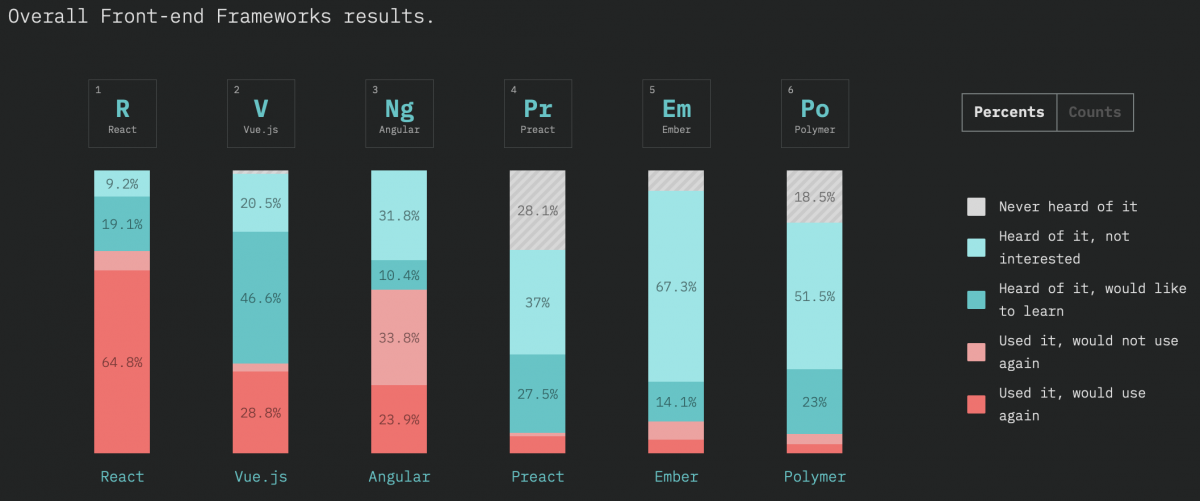6 Web Design Trends That Are Growing in Popularity

Web development is a field that pushes for change every year. From new programming languages to improvements in design, building successful web applications requires you to stay in touch with the current technology and trends. This article covers a selection of fast-growing trends that you should keep an eye out for this year.
Progressive Web Apps
A progressive web app is a web application designed to resemble and function like a native mobile app. Unlike native apps, these apps have a URL. Search engines index these applications which make them easily discoverable. Things to keep in mind while developing a progressive web app (PWA) are as follows.
-
Progressive – Works on all browsers
-
Responsive – Resizes accordingly based on screen size (Including mobile, tablet and laptops)
-
Navigation and interaction similar to those on a native mobile app
-
Provides safety and security through the HTTPS protocol
-
Discoverable by search engines and can be easily shared through a URL
-
Capable of working on low-quality networks as well as offline
Check out this website for ideas and inspiration for building your own progressive web app.
Accelerated Web Pages
Accelerated Mobile Pages or AMP, in short, was a project released by Google and Twitter to enhance the mobile browsing experience. A developer can use this technology to create websites that load instantly and function smoothly. There is a difference of about 20 seconds between the load time of an AMP page and a non-AMP page.
You should keep the following points in mind when working on this open-source technology,
-
AMP is a stripped down form of HTML. Hence you cannot use certain tags (like forms) in your web page.
-
You cannot use Javascript at all in your code. An off-the-shelf Javascript library is available for use that provides features (such as lazy loading) for enhancing the webpage.
-
The design encourages heavy caching.
-
You can validate your AMP page by using a built-in tool on Chrome.
Frontend frameworks
If you have not already started using frameworks for development, you should now. The right front-end framework simplifies and speeds up the development cycle. A web developer uses libraries to build web pages faster. With web pages completed, the developer can focus on optimizing the user experience.
React, Vue.js, and Angular are the top three frameworks available for frontend development in web technology. According to a survey from 2018, React ranked highest on the list of frameworks that developers preferred. It was also the most used library in web development.

API- First Development
Most developers focus on the design of the web application first. Integrating the API connectivity is usually an afterthought. Web applications in 2019 require connectivity between different applications and devices. To support this, a developer should first start working on the APIs required by the application and then build the design on top of the API. Swagger is an open-source tool that helps developers design, build, test, document, and standardize API driven applications. API-first development is also faster than traditional development cycles. This is because the lifecycle parallelizes frontend and backend development.
Incorporation of other technology
Web design is no longer limited to simple user interfaces and experiences. Real-time updates from IoT devices and chatbots powered by AI are fast becoming the norm for websites. Libraries for artificial intelligence like Tensorflow provide “Lite” versions. You can develop applications on web and mobile using these libraries. Chatbots capable of answering most customer queries have also become an integral part of websites. According to Entrepreneur, chatbots offer an engagement factor to a website, making it more interactive and engaging. According to a survey, 65% of people prefer talking to a chatbot than waiting for a response from a human agent. Another factor that can improve visitor engagement is interactive video learning.
Real-time applications are built with web sockets. The websites receive constant information and update themselves automatically. Incorporating blockchain technology for secure transactions on a web application is another example of technology fused with web development. Top companies like IBM and Microsoft are currently exploring ways to use blockchain technology.
Push Notifications
Push notifications are messages that are generated by a website. They work on both desktop and mobile browsers over an SSL connection. Safari 7.0.3 and Chrome 42 support push notifications. The reasons a website should move towards push notifications from the classic email newsletters are as follows,
-
No necessity of downloading a mobile application
-
Re-engage users without access to their personal contact details
-
More users are likely to opt-in to push notifications than emails.
-
Push notifications have a higher conversion rate.
-
There is no risk of being filtered as spam, unlike email notifications.

Source – Push notifications on mobile and desktop
Outside of these key trends, the following are a few more that came close to making this list.
-
Incorporate voice search to your website. Voices searches will make up half of all searches by the next year.
-
Keep your website responsive. This may not be a new trend. However, it is still vital to designing a good website.
-
Reduce the amount of code required by using frameworks and tools such as Google App Maker.
-
Add animations through Motion UI to keep your users engaged. Motion UI is a SAAS framework for creating CSS transitions and animations.
-
If possible, stick to static websites as they load faster and are more secure than dynamic websites.
-
The world is gradually shifting from REST APIs to Facebook’s GraphQL query language.
-
Use cloud technology as a replacement to manually managing your own servers
From static HTML pages to real-time dynamic websites, web technology has come a long way and this is by no means the end. However, navigating the complex and ever-changing world of web technology is no easy task. It always pays to keep abreast of developments in the field and work on navigating your current websites towards these developments.



